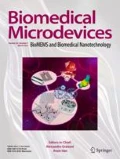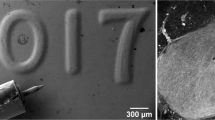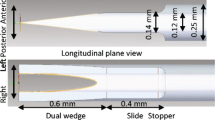Abstract
The cochlea, or inner ear, is a space fully enclosed within the temporal bone of the skull, except for two membrane-covered portals connecting it to the middle ear space. One of these portals is the round window, which is covered by the Round Window Membrane (RWM). A longstanding clinical goal is to reliably and precisely deliver therapeutics into the cochlea to treat a plethora of auditory and vestibular disorders. Standard of care for several difficult-to-treat diseases calls for injection of a therapeutic substance through the tympanic membrane into the middle ear space, after which a portion of the substance diffuses across the RWM into the cochlea. The efficacy of this technique is limited by an inconsistent rate of molecular transport across the RWM. A solution to this problem involves the introduction of one or more microscopic perforations through the RWM to enhance the rate and reliability of diffusive transport. This paper reports the use of direct 3D printing via Two-Photon Polymerization (2PP) lithography to fabricate ultra-sharp polymer microneedles specifically designed to perforate the RWM. The microneedle has tip radius of 500 nm and shank radius of 50 μ m, and perforates the guinea pig RWM with a mean force of 1.19 mN. The resulting perforations performed in vitro are lens-shaped with major axis equal to the microneedle shank diameter and minor axis about 25% of the major axis, with mean area 1670 μ m2. The major axis is aligned with the direction of the connective fibers within the RWM. The fibers were separated along their axes without ripping or tearing of the RWM suggesting the main failure mechanism to be fiber-to-fiber decohesion. The small perforation area along with fiber-to-fiber decohesion are promising indicators that the perforations would heal readily following in vivo experiments. These results establish a foundation for the use of Two-Photon Polymerization lithography as a means to fabricate microneedles to perforate the RWM and other similar membranes.













Similar content being viewed by others
References
P. Bleys, P. Bleys, J.P. Kruth, B. Lauwers, B. Schacht, Surface and Sub-Surface Quality of Steel after EDM. Adv. Eng. Mater. 8(1-2), 15–25 (2006). https://doi.org/10.1002/adem.200500211
X. Chen, O. Nadiarynkh, S. Plotnikov, P.J. Campagnola, Second harmonic generation microscopy for quantitative analysis of collagen fibrillar structure. Nat. Protoc. 7(4), 654–69 (2012)
R.F. Donnelly, T.R. Raj Singh, A.D. Woolfson, Microneedle-based drug delivery systems: microfabrication, drug delivery, and safety. Drug Deliv. 17(4), 187–207 (2010)
Z. Faraji Rad, R.E. Nordon, C.J. Anthony, L. Bilston, P.D. Prewett, J.Y. Arns, C.H. Arns, L. Zhang, G.J. Davies, High-fidelity replication of thermoplastic microneedles with open microfluidic channels. Microsyst. Nanoengineering. 3, 17,034 (2017)
R. Flindt. Amazing Numbers in Biology (SpringerLink: Springer e-Books, Springer, Berlin, 2006)
P. Ga Young, B. HaYoung, M. Il Joon, H. Sung Hwa, C. Yang-Sun, C. Won-Ho, Effects of early surgical exploration in suspected barotraumatic perilymph fistulas. Clin. Exp. Otorhinolaryngol. 5(2), 74–80 (2012). https://doi.org/10.3342/ceo.2012.5.2.74
A.F. Ghiz, A.N. Salt, J.E. DeMott, M.M. Henson, O. Henson, S.L. Gewalt, Quantitative anatomy of the round window and cochlear aqueduct in Guinea pigs. Hear. Res. 162(1), 105–112 (2001). https://doi.org/10.1016/S0378-5955(01)00375-6
S.D. Gittard, R.J. Narayan, Laser direct writing of micro- and nano-scale medical devices. Expert Rev. Med. Devices. 7(3), 343–56 (2010)
M.V. Goycoolea, L. Lundman, Round window membrane. structure function and permeability: a review. Microsc. Res. Tech. 36(3), 201–211 (1997)
M.V. Goycoolea, D. Muchow, P. Schachern, Experimental studies on round window structure: Function and permeability. Laryngoscope. 98(S44), 1–20 (1988). https://doi.org/10.1288/00005537-198806001-00002
K. Gyo, Healing of experimentally produced round window membrane rupture. Acta Oto-Laryngol. 107(1-2), 85–89 (1989). https://doi.org/10.3109/00016488909127483
H. Hahn, B. Kammerer, A. DiMauro, A.N. Salt, S.K. Plontke, Cochlear microdialysis for quantification of dexamethasone and fluorescein entry into scala tympani during round window administration. Hear. Res. 212(1), 236–244 (2006). https://doi.org/10.1016/j.heares.2005.12.001
M. Han, D.K. Kim, S.H. Kang, H.R. Yoon, B.Y. Kim, S.S. Lee, K.D. Kim, H.G. Lee, Improvement in antigen-delivery using fabrication of a grooves-embedded microneedle array. Sens. Actuators B. 137 (1), 274–280 (2009). https://doi.org/10.1016/j.snb.2008.11.017
S. Henry, D.V. McAllister, M.G. Allen, M.R. Prausnitz, in Micromachined needles for the transdermal delivery of drugs. Proceedings MEMS 98. IEEE. Eleventh Annual International Workshop on Micro Electro Mechanical Systems. An Investigation of Micro Structures, Sensors, Actuators, Machines and Systems (Cat. No.98CH36176. https://doi.org/10.1109/MEMSYS.1998.659807, (1998), pp. 494–498
International Organization for Standardization, Accuracy (Trueness and Precision) of Measurement Methods and Results — Part 5: Alternative Methods for the Determination of the Precision of a Standard Measurement Method. Standard ISO 5725-5:1998(En) International Organization for Standardization. Geneva, CH (1998)
H. Izumi, S. Aoyagi, Novel fabrication method for long silicon microneedles with three-dimensional sharp tips and complicated shank shapes by isotropic dry etching. IEEJ Trans. Electr. Electron. Eng. 2(3), 328–334 (2007). https://doi.org/10.1002/tee.20147
C. Kelso, H. Watanabe, J. Wazen, T. Bucher, Microperforations Significantly Enhance Diffusion Across Round Window Membrane. Otol. Neurotol. 36(4), 694–700 (2015)
C.T. Koh, M.L. Oyen, Toughening in electrospun fibrous scaffolds. APL Mater. 3(1),. https://doi.org/10.1063/1.4901450 (2015)
J.P. Kruth, P. Mercelis, V.V. J, L. Froyen, M. Rombouts, Binding mechanisms in selective laser sintering and selective laser melting. Rapid Prototyp. J. 11(1), 26–36 (2005). copyright MCB UP Limited (MCB) 2005; diagrams; illustrations; photographs; graphs; tables; references; Last update - 2014-05-21; CODEN - RPJOFC
E. Larrañeta, R.E. Lutton, A.D. Woolfson, R.F. Donnelly, Microneedle arrays as transdermal and intradermal drug delivery systems: Materials science, manufacture and commercial development. Mater. Sci. Eng. R: Rep. 104, 1–32 (2016). https://doi.org/10.1016/j.mser.2016.03.001
L. Lin, A.P. Pisano, Silicon-processed microneedles. J. Microelectro- mech. Syst.. 8(1), 78–84 (1999). https://doi.org/10.1109/84.749406
H. Liu, J. Hao, K.S. Li, Current strategies for drug delivery to the inner ear. Acta Pharm. Sin. B. 3 (2), 86–96 (2013). https://doi.org/10.1016/j.apsb.2013.02.003
A.A. McCall, E.E.L. Swan, J.T. Borenstein, W.F. Sewell, S.G. Kujawa, M.J. McKenna, Drug Delivery for Treatment of Inner Ear Disease: Current State of Knowledge. Ear and Hearing. 31(2), 156–165 (2010)
P. Mittmann, A. Ernst, I. Todt, Intracochlear Pressure Changes due to Round Window Opening: A Model Experiment. Sci. World J. 2014, 7 (2014)
Nanoscribe GmbH, Nanoscribe GmbH. https://www.nanoscribe.de/en/ (2018)
T.A. Nichols, S.J. Drayton, J. Borckardt, D.J. Taber, Lithium dosing equations: Are they accurate? Ann. Pharmacother. 48(5), 596–600 (2014). https://doi.org/10.1177/1060028014524375
J.H. Park, M.G. Allen, M.R. Prausnitz, Polymer microneedles for controlled-release drug delivery. Pharm. Res. 23(5), 1008–1019 (2006). https://doi.org/10.1007/s11095-006-0028-9
P.K. Venuvinod, W. Ma, Rapid prototyping: laserbased and other technologies. Scitech Book News 28(1), 195–244, Boston, MA: Springer US (2004). https://doi.org/10.1007/978-1-4757-6361-4
S. Plontke, J. Hartsock, R. Gill, A. Salt, Intracochlear Drug Injections through the Round Window Membrane: Measures to Improve Drug Retention. Audiol. Neurotol. 21(2), 72–79 (2016)
S.K. Plontke, R. Mynatt, R.M. Gill, S. Borgmann, A.N. Salt, Concentration gradient along the scala tympani after local application of gentamicin to the round window membrane. Laryngoscope. 117(7), 1191–1198 (2007). https://doi.org/10.1097/MLG.0b013e318058a06b
B. Proctor, B. Bollobas, J.K. Niparko, Anatomy of the round window niche. Ann. Otol. Rhinol. Laryngol. 95(5), 444–446 (1986). https://doi.org/10.1177/000348948609500502, pMID: 3767214
H. Rask Andersen, H. Rask-Andersen, A. Kinnefors, M. Svedberg, R.B. Illing, The human round window - A perilymph pressure regulator? On a novel mechanoreceptor-like neuron in the human round window membrane. Audiol. Med. 2(3), 182–192 (2004). https://doi.org/10.1080/16513860410018213
R. Rezakhaniha, A. Agianniotis, J.T.C. Schrauwen, A. Griffa, D. Sage, C.V.C. Bouten, F.N. van de Vosse, M. Unser, N. Stergiopulos, Experimental investigation of collagen waviness and orientation in the arterial adventitia using confocal laser scanning microscopy. Biomech. Model. Mechanobiol. 11(3), 461–473 (2012). https://doi.org/10.1007/s10237-011-0325-z
A.N. Salt, D.B. Sirjani, J.J. Hartsock, R.M. Gill, S.K. Plontke, Marker retention in the cochlea following injections through the round window membrane. Hear. Res. 232(1), 78–86 (2007). https://doi.org/10.1016/j.heares.2007.06.010
J. Serbin, A. Egbert, A. Ostendorf, B.N. Chichkov, R. Houbertz, G. Domann, J. Schulz, C. Cronauer, L. Fröhlich, M. Popall, Femtosecond laser-induced two-photon polymerization of inorganic–organic hybrid materials for applications in photonics. Opt. Lett. 28(5), 301–303 (2003). https://doi.org/10.1364/OL.28.000301
G. Stevens, S. Flaxman, E. Brunskill, M. Mascarenhas, C.D. Mathers, M. Finucane, Global and regional hearing impairment prevalence: An analysis of 42 studies in 29 countries. Eur. J. Public Health. 23(1), 146–152 (2013). https://doi.org/10.1093/eurpub/ckr176
J.P. Stevens, H. Watanabe, J.W. Kysar, A.K. Lalwani, Serrated needle design facilitates precise round window membrane perforation. J. Biomed. Mater. Res. Part A. 104(7), 1633–1637 (2016). https://doi.org/10.1002/jbm.a.35692
M. Suzuki, T. Sawa, T. Takahashi, S. Aoyagi, in Ultrafine three-dimensional (3d) laser lithographic fabrication of microneedle and its application to painless insertion and blood sampling inspired by mosquito. 2015 IEEE/RSJ International Conference on Intelligent Robots and Systems (IROS), (2015), pp. 2748–2753. https://doi.org/10.1109/IROS.2015.7353754
K. Tanaka, S. Motomura, Permeability of the labyrinthine windows in Guinea pigs. Arch. Oto-Rhino-Laryngol. 233(1), 67–75 (1981). https://doi.org/10.1007/BF00464276
G.A. Von Forell, P.S. Hyoung, A.E. Bowden, Failure modes and fracture toughness in partially torn ligaments and tendons. J. Mech. Behav. Biomed. Mater. 35, 77–84 (2014). https://doi.org/10.1016/j.jmbbm.2014.03.020
T. Yasui, Y. Tohno, T. Araki, Determination of collagen fiber orientation in human tissue by use of polarization measurement of molecular second-harmonic-generation light. Appl. Opt. 43(14), 2861–2867 (2004). https://doi.org/10.1364/AO.43.002861
J. Yu, Y. Zhang, Y. Ye, R. DiSanto, W. Sun, D. Ranson, F.S. Ligler, J.B. Buse, Z. Gu, Microneedle-array patches loaded with hypoxia-sensitive vesicles provide fast glucose-responsive insulin delivery. Proceedings of the National Academy of Sciences. 112(27), 8260–8265 (2015). https://doi.org/10.1073/pnas.1505405112, http://www.pnas.org/content/112/27/8260.full.pdf
Acknowledgments
The authors gratefully acknowledge Professor Elizabeth Olson, Charlotte Prevoteau, Wenbin Wang, Dimitrios Fafalis, and Arnuparp Santimetaneedol for helpful discussions. Dr. Charles Emala, M.D. generously provided euthanized guinea pigs with intact temporal bones through a tissue sharing program at the Institute of Comparative Medicine at Columbia University Medical Center. KEK holds a Career Award at the Scientific Interface from the Burroughs Wellcome Fund and a Clare Boothe Luce Professorship from the Henry Luce Foundation. This work was performed in part at the Advanced Science Research Center NanoFabrication Facility of the Graduate Center at the City University of New York. This research was supported by NIH National Institute on Deafness and Other Communication Disorders of the National Institutes of Health under award number R01DC014547.
Author information
Authors and Affiliations
Corresponding author
Additional information
Karen E. Kasza, Anil K. Lalwani and Jeffrey W. Kysar are Senior Authors.
Hirobumi Watanabe is currently at Kernel.
Rights and permissions
About this article
Cite this article
Aksit, A., Arteaga, D.N., Arriaga, M. et al. In-vitro perforation of the round window membrane via direct 3-D printed microneedles. Biomed Microdevices 20, 47 (2018). https://doi.org/10.1007/s10544-018-0287-3
Published:
DOI: https://doi.org/10.1007/s10544-018-0287-3




